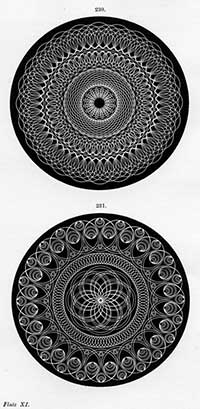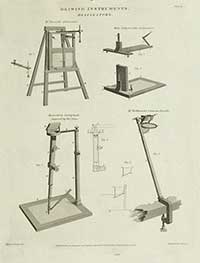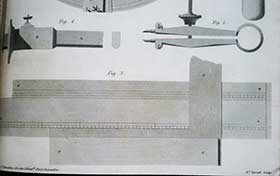
Delineating a Rational Profession:
The Machine Drawings of Engineers in
Early Nineteenth-Century Britain [*]
- Frances Robertson
_______________________________

Fig. 1. Example of patterns generated
by the rose engine lathe, 1894 


In the nineteenth-century, mechanical drawings presented some of the most distinctive and widespread visual statements of the ‘machine dreams' of industrialization [1]. In Britain the genre of engineering drawing developed rapidly with little official training or direction; engineers and draughtsmen were self-trained in drawing, fashioning their own status in a competitive visual economy [2]. Technical representations in large manufacturing enterprises such as heavy engineering or civil infrastructure projects were not simply a means of presenting oneself to the general public, however, but functioned more directly as a means to immediate power in the workplace, a method of exerting control over subordinates at a distance. Distinctive styles of engineering drawing, well known from the work of various celebrated figures such as John Smeaton or James Watt, emerged within the period of ‘industrial enlightenment' around 1800; a public culture where representations alongside exhibitions and lectures created a meaning for machines that merged the mechanical and the philosophical under the banner of improvement [3]. This era of industrial mysticism and invention at the very end of the eighteenth century is the counterpart of the French experience of utopian revolution and encouragement of manufactures in the same period.
Despite the utopian mission of ‘improvement,' the industrial enlightenment was not a jolly consensus; engineers were trying to build professional status as investigators in the rational mechanical science of construction and manufacture, aiming to fend off, variously, natural philosophers, other technical professions, and, increasingly, lower aspiring ranks within their own field. Beyond Britain, there was further national and military conflict that marred the universal cosmopolitan notion of a republic of science. Despite the rational stance promoted by engineers on both sides of the Channel, we see equally strong elements of chaos—revolutionary ideological conflict, economic blockade, and war—creating opportunities for technical professions.
This article considers some surprising artefacts, drawing machines, which at first glance appear to be ludicrously at odds in their miniature scale with the substantial and heroic feats of material production and construction (as in bridges, road systems, or canals) that are supposedly the engineer’s unique field of operations [4]. Nevertheless, we see that from the late eighteenth century through to around 1830, engineers, draughtsmen, and other groups in Britain entered into a competitive frenzy to invent mechanical drawing aids. These instruments were displayed in useful arts publications such as the Transactions of the Society of Arts both as objects described in words and pictures, but also through the traces of their use in a very self-referential way [5]. In actual use, many of these devices were fiddly and temperamental, as difficult to build as to operate, prompting the question, why did engineers bother to invent all this paraphernalia? I argue that these toy-like devices contributed just as much as bridges or gargantuan steam-powered machines did to the self-fashioning of engineers and engineering by bringing together several spheres of operation—from the private office to the factory floor—through the medium of publication. Just as the professional engineers developed a range of literary practices—through reports, or popularizing accounts of their work—so they also acted as visual technicians, shaping the genre of technical representation [6]. ‘Machine drawing' created distinctive marks that formed the machine aesthetic in print, working in feedback with developments in technical visual communications in the workplace.
To those who see technical drawing as emanating from the ‘mind’s eye' of the engineer, illustrations are frequently, and misleadingly, characterised as peripheral or non-serious productions [7]. But in fact many different types of mechanical engineers worked as visual technicians and were concerned with technologies of representation on paper, using and inventing drawing machines to manage the literature of professional presentation. While it goes without saying that engineers also devised much of the heavy equipment of industrial knowledge such as paper making machines and printing presses, this was work behind the scenes. With drawing aids, by contrast, engineers inserted their presence directly into the flow of knowledge. They supported their writings with new kinds of image-text combinations and they asserted new forms of drawing skill, where paradoxically the traditional hand craft of the artist was no longer of value. Engineers emphasized the connections between industrial invention, engineering, and printing. In publications that aimed to encourage the useful arts of manufacturing, printing served as a metaphor for industry. Printing appeared to the prophets of industrialization to enact the dream of exact repeatability in the production of multiples. Through the efforts of popularisers such as Charles Babbage, analogies made between printing and industrial production in the nineteenth century became well-worn figures of speech turning endlessly back on themselves [8].
Engineers thought a lot about how to reproduce images both in the workplace and for publication. Exact copies were valued, because images had to be shared and distributed. Technical drawings had contractual status, setting out a promise to clients about something that was going to happen in the future, so draughtsmen aimed for fixed indelible markings that were as unambiguous as possible—for example through using conventional lines of uniform width. Unlike artistic drawing, technical drawing was intended to be a mechanical process that could be reproduced at will and by anyone—the most humble apprentice was expected to copy and reproduce the same drawings as the elite engineer. For these operations simple draughtsmen’s tools such as compass and ruler acted as the most basic reprographic machines, encouraging uniformity and discipline. Engineers also used print as a medium to display allegiance with communities of knowledge and skill beyond the factory or construction site. In the pages of the Transactions of the Society of Arts we see contributors moving around in a carousel of interchangeable roles that join on to other social networks, as inventors, engravers, or draughtsmen. The engraver Wilson Lowry for example, was a member of the Royal Society and a founder member of the Geological Society. The Transactions enlisted celebrity engineers such as Henry Maudslay and Marc Isambard Brunel, famous for their wartime invention of automatic block making machinery for the Navy, as referees to report on new inventions [9].
Drawings for print and for production were two separate genres, different, but in dialogue. Mechanical engineers developed their drawing languages amongst related technical professions, and started that training in the schoolroom. Drawing was a means of professional expression with ruler and compass as basic mark making aids, supported and further elaborated with more specialized equipment, creating a focus on the mechanics of drawing where even seemingly basic and mundane objects like straightedge rulers could gain talismanic status [10]. At a simple level, engineers invented and sold drawing devices because they were entrepreneurs. There was an expansion in trade for optical entertainments in the late eighteenth century, developing alongside new workaday products to meet a market demand for surveying or military equipment, for example when David Napier or James Watt, better known for their steam powered engines, also developed perspective drawing machines, optical aids towards observational drawing. Here we see continuity of skills as well as networking, for many early engineers trained as instrument makers and developed their practice through activities such as surveying, cartography and engraving [11].
[*] I gratefully acknowledge the advice and support of Dr. Alison Morrison-Low, Principal Curator, Science, National Museums of Scotland, Edinburgh, and her co-workers, for granting access to objects in the collection.
[1] H. Sussman, ‘Machine Dreams: The Culture of Technology,’ Victorian Literature and Culture, 28:1, 2000, pp. 197-204.
[2] This was in contrast to the more regulated state-funded technical education systems in France and other European countries; see J.K. Alexander, The Mantra of Efficiency: From Waterwheel to Social Control, Baltimore: Johns Hopkins University Press, 2008; D.S.L. Cardwell, The Organisation of Science in England, London: Heinemann, 1972; J.W. Edmonson, From Mécanicien to Ingénieur: Technical Education and the Machine Building Industry in Nineteenth-Century France, New York and London: Garland Publishing, Inc., 1987; J.H. Weiss, The Making of Technological Man: The Social Origins of French Engineering Education, Cambridge, Mass.: MIT Press., 1982. For accounts of the British experience, see K. Baynes and F. Pugh, The Art of the Engineer,Guildford: Lutterworth, 1981 and C. Fox, The Arts of Industry in the Aage of Enlightenment, New Haven and London: Yale University Press, 2009.
[3] L. Stewart, ‘A Meaning for Machines: Modernity, Utility, and the Eighteenth-Century British Public,’ The Journal of Modern History 70 (2), 1988, p.291; J. Mokyr, The Enlightened Economy: An Economic History of Britain 1700-1850, New Haven: Yale University Press, 2009.
[4] C. MacLeod, Heroes of Invention: Technology, Liberalism and British Identity, 1750-1914, Cambridge: Cambridge University Press, 2007.
[5] The Society of Arts was founded in1754 by William Shipley (1715-1803) as the ‘Society for the Encouragement of Arts, Manufactures, and Commerce,’ later the Royal Society of Arts. The Transactions, the journal of the Society, circulated details of the latest inventions, the latest developments in art and design, and scientific inventions, and also published lists of the latest money prizes (premiums) and medals available (Transactions of the Society for the Encouragement of Arts, Manufactures, and Commerce, 1789-1845). See also R. Yeo, Encyclopaedic Visions, Cambridge: Cambridge University Press, 2001, who discusses British initiatives such as the Encyclopaedia Britannica (first edition 1768-1771), Abraham Rees’s Cyclopaedia (1802-1820), and the Edinburgh Encyclopaedia of David Brewster (1808-1830).
[6] B. Marsden, ‘Re-reading Isambard Kingdom Brunel: Engineering Literature in the Early Nineteenth Century,’ B.Marsden, H. Hutchison and R. O’Connor, eds., Uncommon Contexts: Encounters between Science and Literature, 1800-1914, London, Pickering & Chatto, 2013, pp. 83-109.
[7] E.S. Ferguson, ‘The Mind’s Eye: Non-Verbal Thought in Technology,’ Science 197 (August 26, 1977), pp. 827-36.
[8] D. McKitterick, Print, Manuscript and the Search for Order, 1450-1830, Cambridge: Cambridge University Press, 2003, p. 166.
[9] Maudslay and Brunel had been associated together in developing an automated mechanical technique for making standardised pulley blocks for the Naval Dockyards during the Napoleonic wars. Pulley blocks were complicated wooden connectors used in ship rigging, extremely intricate to shape and put together by hand, but used by the thousand on every ship. Maudslay and Brunel both provided a report on a drawing machine called a ‘curvagraph’ invented and used by one of Brunel’s draughtsmen, Mr. Warcup in 1817 (Society of Arts Transactions 1817, Volume 35, pp. 109-112).
[10] M. Hambly, Drawing Instruments, 1580-1980, London: Sotheby’s Publications, 1988.
[11] Instrument makers promoted their wares in shops, lectures and in print. For example, George Adams, Snr. (c. 1720-1773) was mathematical instrument maker to George III, and also supplied drawing and surveying instruments to the Board of Ordnance and to the East India Company. His son George Adams, Jnr. (1750-95), continuing the business, published Geometrical and Graphical Essays (1791) where he explained how to use and where to purchase drawing instruments (Hambly, ibid., pp. 44-5); the subsequent updated 1813 edition included images of current stock, and an extensive trade catalogue at the end of the book. Instrument makers, surveyors and cartographers were closely involved with new publishing enterprises of this period, with the production of encyclopaedias, maps, and atlases in cities such as London and Edinburgh (see for example A. McConnell, ‘From Craft Workshop to Big Business—The London Scientific Instrument’s Response to Increasing Demand, 1750-1820,’ London Journal 19 (1), 1994, pp. 36-53 or T.N. Clark, A.D. Morrison-Low, and A.D.C. Simpson, Brass and Glass: Scientific Instrument Making Workshops in Scotland, Edinburgh: National Museums of Scotland, 1989.


